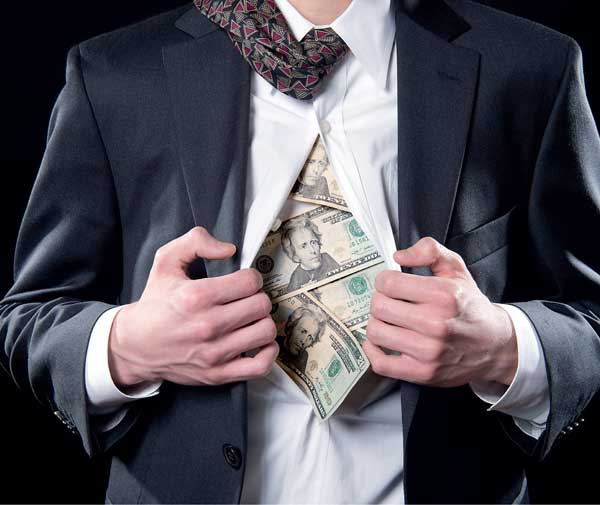12 Oct 2016 - {{hitsCtrl.values.hits}}

 The costs of corporate tax avoidance are massive—and easy to see. But not everyone loses when companies don’t pay their fair share of tax. Indeed, some people (hint—the very, very wealthy) make out like bandits.
The costs of corporate tax avoidance are massive—and easy to see. But not everyone loses when companies don’t pay their fair share of tax. Indeed, some people (hint—the very, very wealthy) make out like bandits.
Tax avoidance is front page news these days, with one presidential candidate claiming nearly US $ 1 billion in losses in a single year, bragging about gaming the system and repeatedly refusing to release his tax returns.
Every year, the United States loses US $ 100 billion to corporate tax dodging. We see the results every day—crumbling roads and bridges, underfunded schools, subways and airports that haven’t been updated in decades. And developing countries lose out even more, as they rely more heavily on corporate tax revenue to fund the schools, hospitals and other essential services they need to lift their citizens out of poverty. With companies dodging tax on such a massive scale, it’s clear that someone is reaping the benefits.
Big corporations go to great lengths not to pay taxes. In April, Oxfam found that the 50 largest US corporations use a network of 1,600 subsidiaries in tax havens to stash US $ 1.4 trillion offshore—all to avoid paying their fair share of taxes. A new report estimated that Fortune 500 companies owe an additional US $ 700 billion in taxes on the mountains of money they have stashed overseas. To companies, a dollar they don’t pay in taxes is another dollar they can add to their bottom line.
But who does that benefit? Companies are owned by their shareholders. Perhaps when companies avoid taxes, that money goes to the retired teachers and firefighters whose pension funds invest in the stock market. If corporate profits were distributed evenly across society, maybe corporate tax dodging wouldn’t be so bad.
New research indicates that is far, far from the case. More and more corporate profits are flowing through opaque ‘pass-through’ corporate structures that are more secretive, pay fewer taxes and are even more heavily tilted toward the super-rich.
Last October, the US Treasury released a paper called, ‘Business in the United States: Who Owns It and How Much Tax Do They Pay?’ The findings were about as tawdry and scandalous as a financial white paper could be.
The big story was the decline of traditional corporations and the rise of pass-through partnerships. Traditional corporations now earn less than half of all business income in the US—while the share earned by pass-through partnerships jumped from 21 percent in 1980 to 54 percent in 2011.
Partnerships pay much lower tax rates. The paper found that partnerships pay an average federal income tax of 19 percent—compared to 32 percent for traditional corporations.
Who benefits?
So who is really benefitting from these lower tax rates? Ownership in traditional corporations is already skewed toward the wealthy—the top one percent (those making more than US $ 450,000 per year) earns 45 percent of corporate income. But it’s even more skewed for partnerships—the top one percent receives 69 percent of pass-through income.
That’s not even the worst of it. While the top one percent is eight times more likely to earn corporate income than the bottom 50 percent of the population, many retired teachers and firefighters do own shares in traditional corporations.
But good luck finding a cop or electrician who earns money from a corporate partnership. The top one percent is an eye-popping 51 times more likely to earn pass-through income than the bottom 50 percent of the population.
Who are these partnerships? Many law firms, accounting firms and medical practices are set up as partnerships—as are hedge funds and private equity firms. But very often, we don’t know.
Treasury found that 20 percent of partnership income is untraceable. One quarter of the owners of partnerships isn’t people at all—they are other partnerships or other corporate entities. And the 75 percent of partners, who are real people, earn only one-third of the money—two-thirds of partnership income accrues to other partnerships or holding companies.
It turns out that having a complicated, secret structure is great for avoiding taxes. Financial and real estate firms pay the lowest tax rate of any sector—15 percent. But the untraceable money does even better, paying just 11 percent—while average Americans pay 31.5 percent of their income in taxes.
Partnerships that own partnerships create levels of complexity and obscurity that make it hard for anyone—including the IRS—to follow the money and know if it’s being properly accounted for and taxed. Too often, these arrangements seem created exclusively for the purpose of hiding income and avoiding taxes—legally or not. Needless to say, these are rules that are rigged for the super-wealthy, not the majority of working women and men who pay taxes when they are automatically withheld from their paycheck.
In the paper, Treasury asked: “Business in the United States: Who Owns It and How Much Tax Do They Pay?” The answer is abundantly clear—the top one percent and not very much.
We all lose when governments are starved from corporate tax revenue. But now it’s equally certain who wins—the super-rich, who vacuum up most corporate earnings and have the most to gain when companies don’t pay their fair share.
(Robbie Silverman is a Senior Advisor in Oxfam America’s Private Sector Department)
10 Jan 2025 54 minute ago
10 Jan 2025 59 minute ago
10 Jan 2025 2 hours ago
10 Jan 2025 2 hours ago
10 Jan 2025 2 hours ago